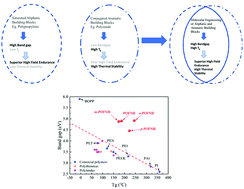Flexible polyolefin dielectric by strategic design of organic modules for harsh condition electrification†
Abstract
Flexible polymers that can withstand temperature and electric field extremes are critical to advanced electrical and electronic systems. High thermal stability of polymers is generally achieved through the introduction of highly conjugated aromatic structures, that lower the bandgap and thus diminish the electric field endurance. Here, we demonstrate a class of flexible all-organic polyolefins by a strategic modular structure design to eliminate the impact of conjugation on bandgap. The one such designed polymer exhibits superior operational temperature and Tg of 244 °C without compromising the bandgap (∼5 eV), exhibiting significantly suppressed electrical conductivity when subjected to a high electric field. It reveals the highest ever recorded energy density of 6.5 J cc−1 at 200 °C, a 2× improvement over the best reported flexible dielectric polymers or polymer composites. The uncovered polymer design strategy introduces a platform for high performance dielectric development for extreme thermal and electric field conditions.



 Please wait while we load your content...
Please wait while we load your content...